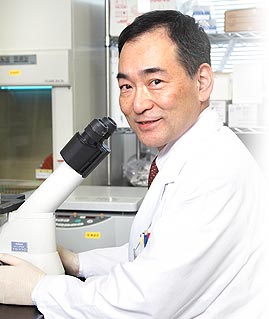
|
Program Overview > Program Members > Shuzo, Matsushita
|

Center for AIDS Research, Professor
Infectious Diseases, M.D., Ph.D. Member of Committee for Education of Young Scientists, Research on HIV-1 humoral immunity


 |
Neutralizing antibodies against HIV-1 have been considered as one of the major component of effective vaccine against AIDS. Much effort has been devoted to elucidate the nature of such antibodies that were able to suppress the replication of primary isolates of HIV-1. However, the specificity of such broadly reactive neutralizing antibodies that inducible in human subject remains unclear. We previously reported for the first time the production of monoclonal antibody (mAb:0.5β) with neutralizing activity against HIV-1 at the 3rd international AIDS Conference at Washington DC in 1987 and the data obtained from 0.5β was published with findings about a critical epitope (V3-loop) for the neutralization of HIV-1 (J. Virol.1988). In collaboration of the research group in Merck, we demonstrated complete protection of chimpanzees by human-mouse chimeric form of the mAb. Cβ1 against the challenge infection of HIV-1 (Nature,1992). We have been successful to produce neutralizing mAbs against other pathogenic retroviruses HTLV-1, HIV-2 and SIV. These researches together with some structural studies using these mAbs had a major impact on the vaccine research against HIV-1 infection. |
|
In spite of these developments there has been few data about the role of neutralizing antibodies in infected individuals. Then we investigated the effect of neutralizing antibodies in vivo in relation to the combination anti-retroviral therapy (ART) and found that development of autologous-virus neutralizing antibodies in the course of ART [1]. However, the antibody response was not broad enough to prevent emergence of resistant variants in vivo. These data suggest that neutralizing antibodies in patients' serum have limited reactivity and are acting as a selective pressure against viral quasispecies in vivo [2]. Recently, we produced humanized mAb (KD-247) that covers 47% of subtype B strains of HIV-1[3]. In other recent study, an R5 HIV-1 strain, JR-FL was exposed to KD-247 to obtain a neutralization-escape mutant. Induction of the neutralization-resistant virus with a mutation in the V3-tip was observed in the presence of a high concentration of KD-247 and the escape variant was found to be more sensitive to CCR5 inhibitors and recombinant soluble CD4 molecule (rsCD4) than the original strain [4]. Induction of neutralization resistant mutants against KD-247 resulted in a highly sensitive phenotype to CCR5 inhibitors. The results together with the data confirming the synergistic effect of the combination support clinical application of KD-247 with CCR5 inhibitors [4]. For the primary viruses we found that the involvement of V2 mutation for the neutralization resistance of anti-V3 antibodies [5]. The accessibility of anti-V3 antibodies was markedly reduced by the mutation in the V2 region in trimer form but not in monomeric gp120. The results suggest involvement of V2 region in "conformational masking" of neutralizing epitope by trimer formation. We believe that an accumulation of these findings of the in vitro selection using current circulating isolates will elucidate the mechanism(s) of escape from the immune suppression in vivo. The phase 1b clinical trial using KD-247 is underway in multiple sites in USA. One of the major obstacles of the vaccine development against AIDS has been referred as "the neutralizing antibody problem" that means difficulty to induce neutralizing antibodies. To solve the problem we are currently working on the determination of the specificities responsible for broad neutralization by isolation and characterization of panels of mAbs. By using these mAbs we are planning to design immunogens that is able to induce antibodies capable of neutralizing a majority of circulating viruses. |
|
 1. Wang, F.X. et al. J. Infect. Dis., 185: 608-617, 2002 2. Kimura, T. et al., J. Infect. Dis., 185: 53-60, 2002 3. Matsushita, S. et al., Human Antibodies: 14, 80-88, 2005 4. Yoshimura, K. et al., AIDS, 20: 2065-2073, 2006 5. Shibata, J. et al., J. Virol., 81: 3757-3768 2007 |
 |
 |